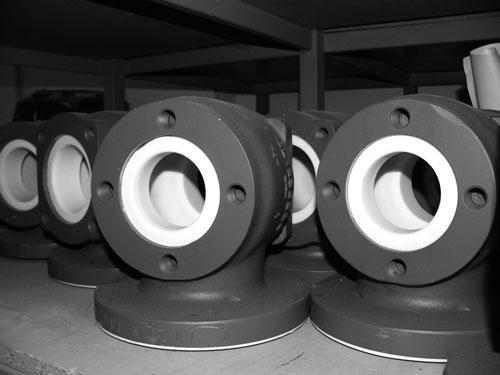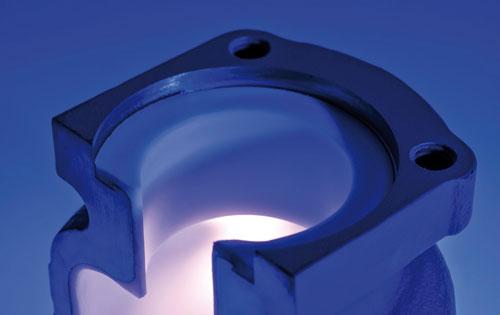PTFE linings turn good products into even better products.
Whether PTFE lining or coating - discover new possibilities for product optimization.
PTFE coatings and linings provide very special product properties
- Universal chemical resistance
- Service temperature from -200 ° C to +260 ° C
- Lowest coefficient of friction of all materials
- Excellent non-stick properties
- Very good electrical insulation properties
These typical PTFE attributes enable almost unlimited possibilities for applications. The material PTFE has been used successfully used for many years in the food industry, pharmacy and medical technology, in the construction industry and in mechanical engineering, in the automotive industry, in aerospace technology, in aircraft construction as well as in electrical engineering and electronics. And the opportunities remain to be unlimited.
We meet individual requirements with specific solutions.
PTFE is not only used in its pure, white natural color. Special properties – for example high wear resistance – are achieved by adding different fillers in different processes. In this way, featured products are achieved that upgrade a component, for example, with a service life that is thousands of times longer than that of pure PTFE.


PTFE is none-aging,
it does not become brittle. In addition, no critical softener migrate and thus the material is environmental friendly. At present more and more of PTFE waste is completely recycled into its original components and after a cleaning process again polymerized into new PTFE.
PTFE is always preferred over other materials if several of its excellent properties are required on the same component. For example, for bridge bearings that require a low coefficient of friction and are exposed to ambient temperatures from -50 ° C to + 50 ° C. Or as electrical insulation that is subject to extreme temperature fluctuations in the aerospace industry. PTFE parts are also required for dental treatment to generate oil-free air. In the paper and printing industry, roller covers, slide rails and deflection pieces made of PTFE ensure that sheets of paper slide easily and without contamination. The material is used in a variety of ways in the food industry – for example in filling machines for a wide variety of liquids or in bakeries as roller or slideways for baked goods. The chemical industry uses PTFE to line containers and pipes and they use it as seals. In addition to chemical resistance, excellent non-stick properties and high heat resistance are also required in such applications.
Due to its excellent electrical properties, PTFE is used specifically in high-frequency technology. The very low dielectric constant of 2.1 and the dielectric loss factor of tan δ <0.0001 enable the material to be used as a transmitting and receiving antenna in radar and microwave devices. In combination with other properties – such as the universal chemical resistance to acids and alkalis or ageing resistance – PTFE is very well suited for use as a signal transmitter and receiver for level measurements in tanks, but also outdoor for radio and radar systems. Molded, solid and filigree components made of PTFE guarantee for the functional and economic requirements in the high frequency range.
With the precise machining technology of the experienced service provider Beichler & Grünenwald, the molded parts achieve maximum accuracy.
Since PTFE is a very valuable plastic, it is almost always worthwhile to produce molded parts that come as close as possible to the final component. That is why Beichler & Grünenwald is focussing on this target. Self-made tools using hydraulic and isostatic presses are used for this kind of production. Technically, both linings of metal cases and linings of metal cores can be made in any shape. A machine park state of the art of CNC-controlled milling and turning centers ensure the required precision of the components. Beichler & Grünenwald also manufactures molded parts and components by extruding round, hollow, flat and special profiles that can be produced in almost any length. We also use these profiles to manufacture ready-to-install parts. With our combined automatic lathes and milling machines, which are specially designed for processing profile bars, we work extremely precisely, but also very economically.
Semi-finished PTFE products are manufactured either by hydraulic or isostatic presses. The difference between the two processes is the direction in which the semi-finished goods are produced. The output of both moulding techniques are sintered in special furnaces.
In hydraulic moulding, PTFE granulate is compressed into simple shaped parts by using moulds in combination with hydraulic pressure. The obtained goods are sintered in the furnace using precisely defined sintering programs. The isostatically pressed blanks are sintered in the same way. Before that, however, the PTFE granulate is placed in tailor-made tools – very close to the contour of the finished part – and pressure is applied from all sides. For finished parts with extremely complex shapes, this is the most efficient way of processing PTFE.